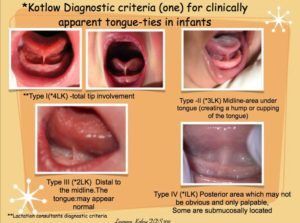Lip and Tongue Ties
What is Ankyloglossia?
“Embryological remnant of tissue in the midline between the undersurface of the tongue and the floor of the mouth that restricts normal tongue movement.”
Tongue position and jaw development
- Mouth breathing, tongue-tie and non-nutritive sucking habits (e.g. thumb sucking, finger sucking, dummy sucking and tongue sucking) affect tongue posture inside the mouth.
- These habits can cause a “low tongue resting posture”, which means the tongue sits low in the mouth rather than assuming its natural resting position against the roof of the mouth behind the top teeth.
- A low tongue resting posture can have a profound effect on the growth and development of a child’s oral cavity and upper airway if this habit continues over a prolonged period of time.
“Low rest tongue posture” is considered a Myofunctional Disorder
- Orofacial Myofunctional Disorders (OMDs) are disorders of the muscles and functions of the face and mouth.
- OMDs may affect, directly and/or indirectly, breastfeeding, facial skeletal growth and development, chewing, swallowing, speech, occlusion, temporomandibular joint movement, oral hygiene, stability of orthodontic treatment, facial esthetics, and more.
- During the act of swallowing, (deglutition), and/or during rest posture, an incorrect positioning of the tongue may contribute to improper orofacial development and maintenance of the misalignment of the teeth.
- The presence of a myofunctional disorder may have a negative effect on the development of the dentition, particularly the eruption patterns and/or alignment of the teeth and jaws.




